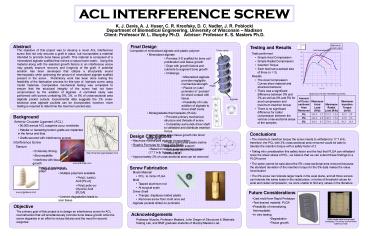ACL INTERFERENCE SCREW - PowerPoint PPT Presentation
1 / 1
Title:
ACL INTERFERENCE SCREW
Description:
The objective of this project was to develop a novel ACL interference screw that ... Anterior Cruciate Ligament (ACL) www.jnjgateway.com. www.arthrotek.com ... – PowerPoint PPT presentation
Number of Views:497
Avg rating:3.0/5.0
Title: ACL INTERFERENCE SCREW
1
ACL INTERFERENCE SCREW
K. J. Davis, A. J. Huser, C. R. Kreofsky, D. C.
Nadler, J. R. Poblocki Department of Biomedical
Engineering, University of Wisconsin
Madison Client Professor W. L. Murphy Ph.D.
Advisor Professor K. S. Masters Ph.D.
Abstract
Final Design
Maximum Axial Load
Testing and Results
The objective of this project was to develop a
novel ACL interference screw that not only
secures a graft in place, but incorporates a
material intended to promote bone tissue growth.
This material is composed of a mineralized
alginate scaffold that mimics a natural bone
matrix. Using this material along with the
selected growth factors in an interference screw
may greatly improve recovery and longevity of the
graft. A potential solution has been developed
that utilizes a structurally sound thermoplastic
while optimizing the amount of mineralized
alginate scaffold present in the screw.
Preliminary work has been done testing the
feasibility of the fabrication process for this
type of biphasic screw using model materials.
Comparative mechanical testing was completed to
ensure that the structural integrity of the screw
had not been compromised by the addition of
alginate. A controlled study was performed with
screws containing 0, 2, or 5 of
cross-sectional area alginate pocket cutouts.
Experimental data suggests the 2 cross-sectional
area alginate pockets can be incorporated
however, more testing is required to determine
the maximum pocket size.
- Composite of mineralized alginate and plastic
polymer - Mineralized alginate
- Provides 3-D scaffold for bone cell
proliferation and tissue growth - Dope with growth factors and nutrients to
augment bone growth - Challenge
- Mineralized alginate provides negligible
mechanical strength - Placed on outer perimeter in pockets for
direct contact with tissue - Possibility of in situ addition of alginate to
driver shaft cavity - Biodegradable thermoplastic (PLGA)
- Provides primary mechanical structure and
threads of screw. - Completely surrounds driver shaft to withstand
and distribute insertion forces. - Growth holes allow tissue growth into driver
shaft cavity - Tissue surrounds plastic before degradation for
support - Increases osteo-conductive environment
Driver cavity
- Tests performed
- Simple Axial Compression
- Simple Radial Compression
- Insertion Torque
- Each test had a sample size of three (n 3)
- Results
- The Axial Compression Curves show material and
structural behavior - There was a significant difference between 0 and
2 as well as 0 and 5 for axial compression and
maximum insertion torque - There is no significant difference for radial
compression between the various cross-sectional
areas of the samples
Plastic
Maximum Forces Tolerated by Screw
Alginate
Conclusions
Design Calculations
- The maximum insertion torque the screw needs to
withstand is 17.7 in.lb therefore, the PCL with
2 cross-sectional area removed would be able to
tolerate the insertion torque with a safety
factor of 2 - Taking into consideration this safety factor and
the fact that PLGA can withstand twice the shear
stress of PCL, we believe that we can extend
these findings to a PLGA screw - The same cannot be said about the 5
cross-sectional area removed because the standard
deviation of the insertion torque for the 5 data
makes the value inconclusive - The 0 screw can tolerate larger loads in the
axial plane, and all three screws can tolerate
the same loads in the radial plane in terms of
threshold values for axial and radial
compression, we were unable to find any values in
the literature
- Maximize mineralized alginate incorporation
- Roarks Formulas for Stress and Strain
- Based on known surgical insertion torque (17.7
in.lb Nyland, J et al.) - Approximately 2 of cross-sectional area can be
removed
Screw Fabrication
- Model Material
- PCL to mimic PLGA
- Mold
- Tapped aluminum rod
- At surgical scale
- Driver Shaft
- Triangle displaces melted plastic
- Removes screw from mold once set
- Alginate pockets drilled on perimeter
Future Considerations
- Cast mold from Rapid Prototype
- Test desired material PLGA
- Possibility of mineralizing
- thermoplastic
- In vitro testing
- Degradation
- Tissue growth
Objective
The primary goal of this project is to design an
interference screw for ACL reconstruction that
will simultaneously promote bone tissue growth
while the screw degrades in an effort to reduce
failures and the need for second surgeries.
Acknowledgements
Professor Murphy, Professor Masters, John Dreger
of Structures Materials Testing Lab, and BME
graduate students of Murphy/Masters Lab.
Plastic model made through rapid prototyping.
This shows one half of the scaled-up model.































